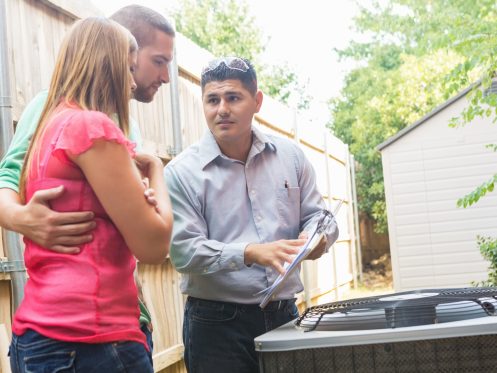One type of HVAC system that has received a lot of press lately is the heat pump. This is a unique system that provides both heating and cooling for a home. If you’re unfamiliar with what this type of system is and how it works, we’ll go into more detail below.
What Exactly Is a Heat Pump?
One of the simplest ways to describe a heat pump is as a heat transfer system. It focuses on absorbing heat in one location and moving it to another area. In the summertime, it focuses on absorbing heat from inside your home and transporting it to the air outside. The complete opposite happens during the winter months when heat moves from outside to inside.
What Are the Parts of a Heat Pump?
There are two large components that make up a heat pump system. The first is the indoor air handler unit. If you have a ducted heat pump, this will be one unit. On the other hand, if you have a ductless setup, then you’ll have multiple indoor air handler units, commonly referred to as mini-splits. Inside the unit will be a blower fan that’s responsible for moving air in and out of the unit. It will also have an evaporator coil that’s responsible for absorbing and releasing heat depending on the season.
The second main component is the outdoor condenser unit. This unit features a blower fan as well as a coil referred to as the condenser coil. The indoor air handler unit connects directly to the outdoor condenser unit via copper tubing. Inside the copper tubing and in both the evaporator and condenser coils is a substance known as refrigerant. This substance is the key to how a heat pump operates.
How Does This HVAC System Work?
To best understand how the system works, we’ll focus on how it effectively cools your home during the hot summer months. Despite its name, heat pumps are a solid air conditioning system in addition to their heating capability. The cooling process starts at your indoor air handler unit. The unit will pull in hot air from the rooms in your home and pass it over the evaporator coil. The system relies on the physical property that heat naturally wants to move from high-pressure substances to low-pressure substances.
As hot air passes over the evaporator coil, heat will naturally transfer from the air to the refrigerant inside the coil. During this process, excess humidity is removed from the air as condensation forms on the surface of the evaporator coil. The now cold air gets circulated back into your home to decrease its overall temperature.
As the refrigerant heats up, it will turn into a gaseous state. The heat pump’s compressor is responsible for circulating refrigerant throughout the system. It will circulate the hot refrigerant from your indoor air handler unit all the way out to the condenser unit. At the condenser unit, a blower fan will pull in outdoor air and pass it over the condenser coil.
Heat will naturally move from the refrigerant inside the condenser coil to the air because the outdoor air has lower pressure. The refrigerator will continue to move back toward the indoor air handler unit. On its journey, it will pass through an expansion valve. This valve is responsible for turning the refrigerant back into a low-pressure, liquid state.
A Note About Heat Pump Heating
Just as your heat pump provides air conditioning in the summertime, it can provide heating for your home in the wintertime. It does this by operating in the complete opposite direction as it does in the summertime. It can do this because the expansion valve inside your heat pump is reversible.
During the winter months, the condenser unit will pull in air from the outdoors. As it passes over the condenser coil, heat gets absorbed into the refrigerant. The system’s compressor pump circulates that warm refrigerant into the evaporator coil inside your indoor air handler unit. As low-pressure cold air from inside your home passes over the evaporator coil, heat will transfer from the refrigerant to the air.
This warm air then returns to the various rooms of your home thanks to the blower fan. The refrigerant gets pumped back out to the outdoor condenser unit where it goes through the expansion valve for it to turn back into a low-pressure liquid refrigerant.
Expert Heat Pump Service
GVEC Air Conditioning & Heating offers expert heating services for homeowners throughout Gonzales and New Braunfels, TX. That includes expert heat pump repair, installation, and maintenance, Our technicians will assist with all your cooling, commercial HVAC, ductwork, indoor air quality, and energy audit needs. Call our office today to schedule your next service appointment.



